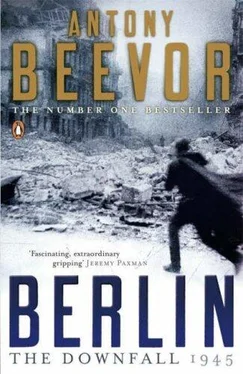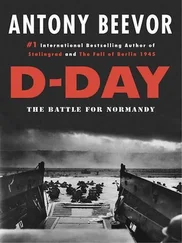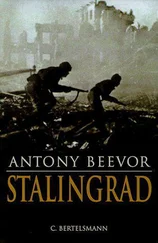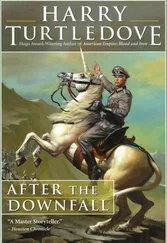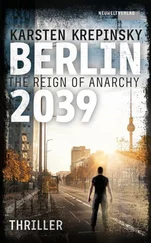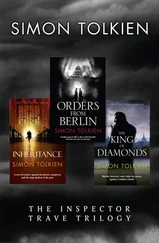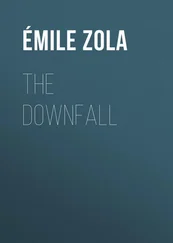Himmler talked about the panzerfaust as if it were another miracle weapon, akin to the V-2. He enthused about how wonderful it was for close-quarter fighting against tanks, but any sane soldier given the choice would have preferred an 88mm gun to take on Soviet tanks at a distance of half a kilometre. Himmler was almost apoplectic about rumours that the panzerfaust could not penetrate enemy armour. Such a story, he asserted, was ‘ ein absoluter Schwindel!’.
With the enemy so close, it appears that the Nazi leadership had started to consider the possibility of suicide. The headquarters of Gau Berlin issued an order that ‘political leaders’ were to receive top priority for firearms certificates. And a senior executive in a pharmaceutical company told Ursula von Kardorff and a friend of hers that a ‘Golden Pheasant’ had appeared in his laboratory demanding a supply of poison for the Reich Chancellery.
Hitler and his associates now finally found themselves closer to the very violence of war which they had unleashed. Revenge for the recent executions of men associated with the July plot arrived in unexpected form less than two weeks after the event. On the morning of 3 February, there were exceptionally heavy US Air Force raids on Berlin. Some 3,000 Berliners died. The newspaper district, as well as other areas, was almost totally destroyed. Allied bombs also found Nazi targets. The Reich Chancellery and the Party Chancellery were hit and both Gestapo headquarters in the Prinz-Albrechtstrasse and the People’s Court were badly damaged. Roland Freisler, the President of the People’s Court, who had screamed at the accused July plotters, was crushed to death sheltering in its cellars. The news briefly cheered dejected resistance circles, but rumours that concentration camps and prisons had been mined made them even more alarmed for relatives and friends in detention. Their only hope was that Himmler might keep them as bargaining counters. Martin Bormann in his diary wrote of the day’s air raid: ‘Suffered from bombing: new Reich Chancellery, the hell of Hitler’s apartments, the dining room, the winter garden and the Party Chancellery.’ He seems to have been concerned only with the monuments of Nazism. No mention was made of civilian casualties.
The most important event on Tuesday 6 February, according to. Bormann’s diary, was Eva Braun’s birthday. Hitler, apparently, was ‘in a radiant mood’, watching her dance with others. As usual, Bormann was conferring privately with Kaltenbrunner. On 7 February, Gauleiter Koch, apparently forgiven for having abandoned Königsberg after all his orders to shoot those who left their place of duty, had discussions with Hitler. That evening, Bormann dined at the Fegeleins. One of the guests was Heinrich Himmler, whom he, Fegelein and Kaltenbrunner were seeking to undermine. The situation at the front was disastrous, yet Himmler, although commander-in-chief of Army Group Vistula, felt able to relax away from his headquarters. After supper Bormann and Fegelein talked with Eva Braun. The subject was probably her departure from Berlin, for Hitler wanted her out of danger. The next night she held a small farewell party for Hitler, Bormann and the Fegeleins. She left for Berchtesgaden the following evening, Friday 9 February, with her sister Gretl Fegelein. Hitler made sure that Bormann escorted them to the train.
Bormann, the Reichsleiter of the National Socialist Party, whose Gauleiters had in most cases stopped the evacuation of women and children until it was too late, never mentions in his diary those fleeing in panic from the eastern regions. The incompetence with which they handled the refugee crisis was chilling, yet in the case of the Nazi hierarchy it is often hard to tell where irresponsibility ended and inhumanity began. In an ‘Evacuation Situation’ report of 10 February, they suddenly realized that with 800,000 civilians still to be rescued from the Baltic coast, and with trains and ships taking an average of 1,000 people each, ‘There are neither enough vessels, rolling stock nor vehicles at our disposal.’ Yet there was no question of Nazi leaders giving up their luxurious ‘special trains’.
On the morning of 2 February, just as the first German counter-attacks were launched against the Oder bridgeheads, the USS Quincy reached Malta. ‘The cruiser which bore the President,’ wrote Churchill, ‘steamed majestically into the battle-scarred’ Grand Harbour of Valetta. He went on board to greet Roosevelt. Although Churchill did not acknowledge that the President was ill, his colleagues were shaken to see how exhausted he looked.
The reunion between the two men was friendly, if not affectionate, yet Churchill’s foreign secretary, Anthony Eden, was worried. Tension had continued to grow between the Western Allies over the invasion of Germany from the west. Now they were about to fly to Yalta in the Crimea to decide the post-war map of central Europe with Stalin. They were divided on this too, while the Soviet leader knew exactly what he wanted. Churchill and Eden were most concerned about the independence of Poland. Roosevelt’s main priority was the establishment of the United Nations for the post-war world.
In separate aircraft, the President and the Prime Minister took off in the early hours of 3 February. Escorted by long-range Mustang fighters, and with no cabin lights showing, they flew east towards the Black Sea, following a fleet of transport aeroplanes carrying the two delegations. They arrived after a flight of seven and a half hours at Saki near Eupatoria. There, they were met by Molotov and Vyshinsky, the former prosecutor at the show trials and now deputy foreign minister. Stalin, who suffered from a terrible fear of flying, did not arrive until the next morning, Sunday 4 February. He had travelled down from Moscow in his green railway carriage, still with some of its Art Nouveau decoration from Tsarist days.
The American chiefs of staff were housed in the Tsar’s former palace. General George C. Marshall found himself in the Tsarina’s bedroom, with a secret staircase allegedly used by Rasputin. Their British counterparts were in Prince Vorontsov’s Castle of Alupka, an extravagant mid-nineteenth-century mixture of Moorish and Scottish baronial. President Roosevelt, to save him any more journeys, was installed in the Livadia Palace, where the main discussions were to take place. So much had been wrecked during the fighting in the Crimea and the German withdrawal that major works, including complete replumbing, had been carried out at great speed by the Soviet authorities to make these palaces habitable. Amid the terrible war damage, no efforts were spared to entertain their guests with banquets of caviare and Caucasian champagne. Churchill could not resist calling this coast of ghostly summer palaces the ‘Riviera of Hades’. Not even he suspected that all their rooms had been bugged. The NKVD had also positioned directional microphones to cover the gardens.
Stalin visited Churchill that afternoon, keen to convey the impression that the Red Army could be in Berlin in no time. He then paid his respects to President Roosevelt. With Roosevelt, his manner became almost deferential and his version of events changed completely. Stalin now emphasized the strength of German resistance and the difficulty of crossing the River Oder. Roosevelt was certain that he, not Churchill, knew how to handle the Soviet leader and Stalin played up to this. Roosevelt believed that it was just a matter of winning Stalin’s trust, something which Churchill could never do. He even admitted openly his disagreements with the British over the strategy for the invasion of Germany. When he suggested that Eisenhower should have direct contact with the Stavka, Stalin encouraged the idea warmly. The Soviet leader saw the advantages of American frankness, while giving away little in return.
Читать дальше
